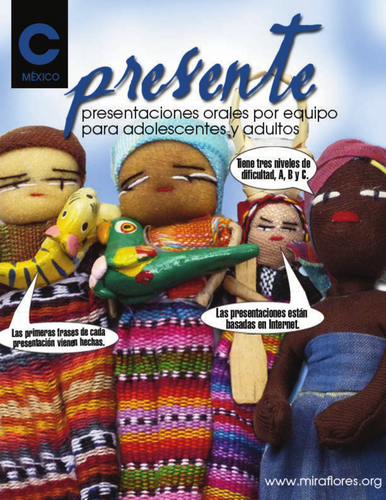
Presente C has 6 broad themes devoted to Mexico. Eclectic and fun, students learn about the great variety this beautiful country offers.
1. ¿Salen de vacaciones? - Students convince their classmates to visit a specific place. An example:
- Yo recomiendo Taxco. Hay muchas tiendas donde venden joyería de plata. Hay artistas que hacen joyas.
Palabras clave: Taxco + joyería de plata
- ¿Van a México? Para comprar alebrijes, las famosas figuras de madera tallada, tienen que ir a Oaxaca. Visiten a la familia Mendoza, Luis Pablo, Moisés Pablo y David Pablo Mendoza. Les va a encantar.
Palabras clave: Oaxaca + alebrijes
2. Dos culturas antiguas - Assignments totally out of the box with comparisons between ancient Egypt and the Aztec world.
- Vamos a hablar de la ropa de los aztecas y de los egipcios antiguos. Vamos a explicar las diferencias.
Palabras clave: aztecas + ropa; egipcios antiguos + ropa
3. Diego y Frida - Iconic painters who were married to each other on two separate occasions and produced very different work. Students show the painting, describe it and relate it to the painter´s life.
- Voy a describir un cuadro, «Las dos Fridas» (1939). Luego voy a responder a la pregunta: ¿Por qué es Frida Kahlo un icono feminista?
Palabras clave: «Las dos Fridas»
4. Lugares inolvidables - Mexico is blessed with mountains and beaches, deserts and tropical forests. An example:
- Ustedes saben que a mí me gustan mucho los viajes. Tuve ocasión de ir a México y allí visité el Parque Museo La Venta y vi las cabezas gigantes de los olmecas. Toda una maravilla.
Palabras clave: Parque Museo La Venta
5. Volcanes - science and ecology can be understood by all.
6. Abrimos un restaurante - Starting with the rental of the space, the students work their way through the furnishing, decorating, preparing the menu, and more. Great fun.
- Vamos a decorar el restaurante con grandes recipientes de cobre hechos en Santa Clara del Cobre. Les voy a mostrar y explicar los objetos de cobre…
Palabras clave: Santa Clara del Cobre
1. All oral presentation topics are based on research. Key words are provided to guide the student's web research. Guidelines for research are provided. Cooperative learning is required. Suggestions are given for audience response.
2. All oral topics have three levels of difficulty, A, B and C. Each level is on a separate page so teacher can choose.
3. Level A provides the student 3 suggestions, level B gives the student 4 suggestions and level C, 6 suggestions. Group work is required to divide the work and prepare for a class presentation.
4. There is always a central theme. All topics are guided. First sentences are provided.
Number of pages: 23
Teacher and student rubrics: included
Store name: MirafloresCultura
International Baccalaureate
1. ¿Salen de vacaciones? - Students convince their classmates to visit a specific place. An example:
- Yo recomiendo Taxco. Hay muchas tiendas donde venden joyería de plata. Hay artistas que hacen joyas.
Palabras clave: Taxco + joyería de plata
- ¿Van a México? Para comprar alebrijes, las famosas figuras de madera tallada, tienen que ir a Oaxaca. Visiten a la familia Mendoza, Luis Pablo, Moisés Pablo y David Pablo Mendoza. Les va a encantar.
Palabras clave: Oaxaca + alebrijes
2. Dos culturas antiguas - Assignments totally out of the box with comparisons between ancient Egypt and the Aztec world.
- Vamos a hablar de la ropa de los aztecas y de los egipcios antiguos. Vamos a explicar las diferencias.
Palabras clave: aztecas + ropa; egipcios antiguos + ropa
3. Diego y Frida - Iconic painters who were married to each other on two separate occasions and produced very different work. Students show the painting, describe it and relate it to the painter´s life.
- Voy a describir un cuadro, «Las dos Fridas» (1939). Luego voy a responder a la pregunta: ¿Por qué es Frida Kahlo un icono feminista?
Palabras clave: «Las dos Fridas»
4. Lugares inolvidables - Mexico is blessed with mountains and beaches, deserts and tropical forests. An example:
- Ustedes saben que a mí me gustan mucho los viajes. Tuve ocasión de ir a México y allí visité el Parque Museo La Venta y vi las cabezas gigantes de los olmecas. Toda una maravilla.
Palabras clave: Parque Museo La Venta
5. Volcanes - science and ecology can be understood by all.
6. Abrimos un restaurante - Starting with the rental of the space, the students work their way through the furnishing, decorating, preparing the menu, and more. Great fun.
- Vamos a decorar el restaurante con grandes recipientes de cobre hechos en Santa Clara del Cobre. Les voy a mostrar y explicar los objetos de cobre…
Palabras clave: Santa Clara del Cobre
1. All oral presentation topics are based on research. Key words are provided to guide the student's web research. Guidelines for research are provided. Cooperative learning is required. Suggestions are given for audience response.
2. All oral topics have three levels of difficulty, A, B and C. Each level is on a separate page so teacher can choose.
3. Level A provides the student 3 suggestions, level B gives the student 4 suggestions and level C, 6 suggestions. Group work is required to divide the work and prepare for a class presentation.
4. There is always a central theme. All topics are guided. First sentences are provided.
Number of pages: 23
Teacher and student rubrics: included
Store name: MirafloresCultura
International Baccalaureate
Something went wrong, please try again later.
This resource hasn't been reviewed yet
To ensure quality for our reviews, only customers who have purchased this resource can review it
Report this resourceto let us know if it violates our terms and conditions.
Our customer service team will review your report and will be in touch.
$10.00
